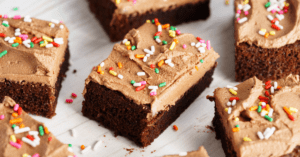Cake Flour vs. All-Purpose flour: is there really a difference?
Yes, there is a difference, but it’s subtle.

You may find that a recipe calls for cake flour, but you only have all-purpose flour. No worries!
In most recipes, all-purpose flour will still create a delicious cake.
But the texture will be slightly off. And you won’t get that Paul Hollywood handshake.
Knowing the difference between cake flour and all-purpose flour is essential in baking.
So, let’s look at the differences between cake flour vs. all-purpose flour. And you might get that handshake, yet.
Cake Flour vs. All-Purpose Flour (What’s the Difference?)
The main differences between cake flour and all-purpose flour are protein and texture.
Cake flour is ultra-fine, which produces a cake with a very light crumb. Think angel food cake. Plus, cake flour can also contain cornstarch.
(Sometimes. Some brands do, and others do not.)
All-purpose flour isn’t ground as fine. And it contains no cornstarch. So, your cake won’t be as delicate and spongy.
Another big difference between the two is their protein content.
Flours with a high protein content develop more gluten. For bread, you want a super-high protein content for dense bread-like dough.
For cakes, lower protein content is ideal for a delicate treat.
Cake flour has a protein content of 8-10 percent. All-purpose flour has a protein content of 11.7 percent.
The percentage difference is tiny. But it can make a BIG difference in the texture of your cakes and cookies.

What Is Cake Flour?
Milling soft wheat to an ultra-fine consistency produces cake flour. Sometimes, brands add cornstarch for extra lightness.
Cake flour stands out for its distinct qualities of low protein content (gluten) and fine consistency.
But its name does not limit this type of flour to cake recipes alone!
You can also use it in recipes requiring a light texture. Snickerdoodle cookies are a fantastic example.
It’s a fabulous flour for whipping up delicate cakes or tender cookies.
There’s no comparison to an angel food cake made with cake flour!
When to Use Cake Flour
You can use cake flour in recipes that call for a fluffy crumb. For example, angel food cakes or chiffon cakes.
Cake flour is also great in other delicate desserts like muffins, scones, and sponge cakes.
In cookies, it helps to create a more delicate crumb. It is ideal for sugar cookies!

What Is All-Purpose Flour?
All-purpose flour combines soft and hard wheat for a medium range of gluten.
Think of all-purpose flour as the Goldilocks of flour.
It offers the ideal gluten balance for recipes ranging from bread dough to cake. It has a medium-fine consistency.
When to Use All-Purpose Flour
All-purpose flour is the workhorse of the kitchen. It does just about anything.
This flour is in recipes for bread, dumplings, biscuits, cookies, pizza dough, and muffins.
When in doubt, all-purpose flour works in a pinch.
Some cake recipes benefit from all-purpose flour rather than cake flour!
If your cake has many wet ingredients, all-purpose flour works better than cake flour.
So, you will use it in treats like carrot cake, banana bread, and Hummingbird cake. Plus, many more recipes.

Can You Substitute All-Purpose Flour for Cake Flour?
Yes. You can substitute all-purpose flour for cake flour, and your cake will be just fine.
Your cake batter may look the same as one made with cake flour. But the difference emerges after baking.
Cakes with all-purpose flour won’t be as delicate, and the texture will seem somewhat off.
And with angel food cake, all-purpose flour won’t yield the same impressive rise.
Your dessert will still taste sweet and fantastic. But it will not be as delicate and light.
How to Convert All-Purpose Flour to Cake Flour
Don’t have cake flour and don’t want to visit the store? Don’t worry. You can make your own at home!
The best way to make cake flour is by combining cornstarch with all-purpose flour. This dilutes the gluten content in all-purpose flour.
Here’s an easy way to make homemade cake flour:
- Spoon all-purpose flour into a 1-cup measuring cup.
- When the cup is full, level it off with the back of a butter knife.
- Remove 2 tablespoons of all-purpose flour from the measuring cup.
- Add 2 tablespoons of cornstarch.
- Sift through a metal sieve until ultra-fine (you may have to do it twice).
- Use it as a replacement in your recipe.
Do this for every 1 cup of cake flour required.
Easy peasy!
The cornstarch helps to dilute the proteins in all-purpose flour to achieve that delicate crumb.

Can You Substitute Cake Flour for All-Purpose Flour?
There is no substitute for all-purpose flour!
You can swap all-purpose for cake flour, but the opposite is not possible. Try it, and your bakes will not achieve your desired rise.
Treats requiring all-purpose flour need a higher gluten content for stability. And cake flour does not have that.
Your cakes will sink, and your cookies will fall apart. No one wants that!
When in doubt, always stock your pantry with all-purpose flour. It is one of the most versatile flours. And it works in pretty much every recipe!











